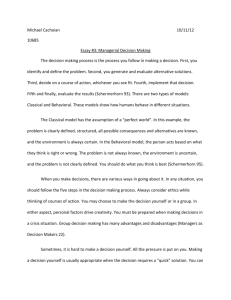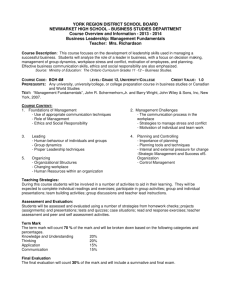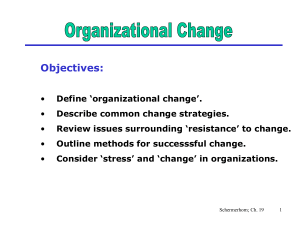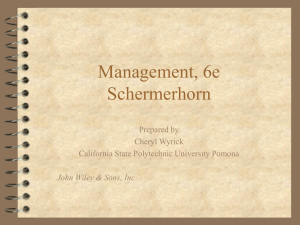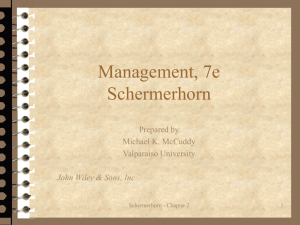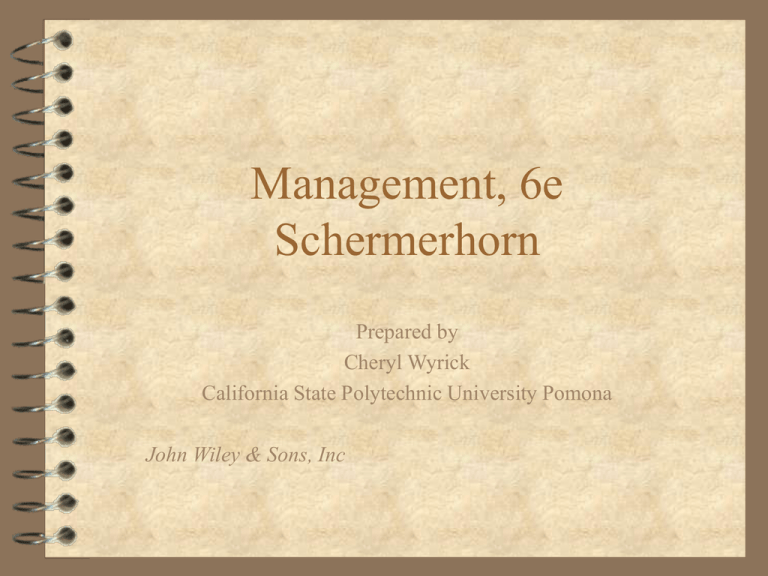
Management, 6e
Schermerhorn
Prepared by
Cheryl Wyrick
California State Polytechnic University Pomona
John Wiley & Sons, Inc
COPYRIGHT
Copyright 1999 © John Wiley & Sons, Inc. All rights reserved.
Reproduction or translation of this work beyond that named in
Section 117 of the United States Copyright Act without the express
written consent of the copyright owner is unlawful. Request for
further information should be addressed to the Permission
Department, John Wiley & Sons, Inc. The purchaser may make
back-up copies for his/her owner use only and not for distribution or
resale. The Publisher assumes no responsibility for errors,
omissions, or damages, cause by the use of these programs or from
the use of the information contained herein.
Chapter 10
Organizing to Create Structures
Planning Ahead
– What is organizing as a management function?
– What are the major types of organization
structures?
– What are the new developments in organization
structures?
– What organizing trends are changing the
modern workplace?
Schermerhorn - Chapter 10
3
Organizing as a Management
Function
What is Organization Structure?
– system of tasks, workflow, reporting
relationships, and communication channels that
link together workgroups
Schermerhorn - Chapter 10
4
Organizing as a Management
Function
Formal Structure
– official working
relationships often
represented by an
organizational chart
Schermerhorn - Chapter 10
5
Organizing as a Management
Function
Informal Structure
– unofficial working relationships
– important in understanding organizations
– sometimes work against best interest of
organizations
Schermerhorn - Chapter 10
6
Traditional Organization
Structures
Functional
– people performing similar tasks are formally
grouped together
– workers share technical expertise, interests, and
responsibilities
Schermerhorn - Chapter 10
7
Traditional Organization
Structures
Advantages of Functional Structures
– economies of scale
– task assignments consistent with expertise
– high-quality technical problem solving
– in-depth training and skill development
– clear career paths
Schermerhorn - Chapter 10
8
Traditional Organization
Structures
Disadvantage of Functional Structures
– functional chimneys problem
• lack of problem solving across functions
Schermerhorn - Chapter 10
9
•Traditional Organization
Structures
Divisional Structures
– groups together employees who work on the
same product or service in the same geographic
area
Schermerhorn - Chapter 10
10
Traditional Organization
Structures
Advantages of Divisional Structures
– more flexibility
– improved coordination
– clear points of responsibility
– expertise focused on specific customers,
products, and regions
– greater ease in restructuring
Schermerhorn - Chapter 10
11
Traditional Organization
Structures
Disadvantages of Divisional Structures
– reduce economies of scale
– increase costs through duplication of resources
across divisions
– create unhealthy rivalries
Schermerhorn - Chapter 10
12
Traditional Organization
Structures
Product Structures
– group together jobs and activities working on a
single product or service
Geographical (Area) Structures
– group together jobs and activities being
performed in the same location or geographical
region
Schermerhorn - Chapter 10
13
•Traditional Organization
Structures
Customer Structures
– group together jobs and activities that are
serving the same customers or clients
Process Structures
– group together jobs and activities that are
related to one another and collectively create
something of value
Schermerhorn - Chapter 10
14
•Traditional Organization
Structures
Matrix Structure
– combination of functional and divisional
structures
– used in
•
•
•
•
manufacturing
service industries
professional fields
nonprofit sector
Schermerhorn - Chapter 10
15
Traditional Organization
Structures
Advantages of Matrix Structure
–
–
–
–
–
–
better interfunctional cooperation
increased flexibility in restructuring
better customer services
better performance accountability
improved decision making
improved strategic management
Schermerhorn - Chapter 10
16
Traditional Organization
Structures
Disadvantages of Matrix Structures
– two-boss system is susceptible to power
struggles
– workers may suffer task confusion
– focused team loyalties to the detriment of
organization
Schermerhorn - Chapter 10
17
Development in Organization
Structures
Team Structures
– cross functional
• more horizontal
Schermerhorn - Chapter 10
18
Developments in Organization
Structures
Advantages of Team Structures
– break down barriers between operating
departments
– boost morale
– improve speed and quality of decisions
Schermerhorn - Chapter 10
19
Developments in Organization
Structures
Disadvantages of Team Structures
– conflicting loyalties among members
– spend a lot of time in meetings
Schermerhorn - Chapter 10
20
Developments in Organization
Structures
Network Structures
– central core that is linked through networks of
relationships with outside suppliers of essential
services
• boundaryless organizations
• virtual corporations
Schermerhorn - Chapter 10
21
Developments in Organization
Structures
Advantages of Network Structures
– operate with fewer full-time employees
– reduced overhead
– increased operating efficiency
– work together across great distances instead of
face-to-face
Schermerhorn - Chapter 10
22
Developments in Organization
Structures
Disadvantages of Network Structures
– coordination of the entire system of
relationships
Schermerhorn - Chapter 10
23
Developments in Organization
Structures
Organizing Trends in the Modern
Workplace
– Shorter Chains of Command
• organizations are reducing levels of management
– Less Unity of Command
• increases in cross-functional teams, task forces, and
horizontal structure
Schermerhorn - Chapter 10
24
Developments in Organization
Structures
Organizing Trends in the Modern
Workplace
– Wider Spans of Control
• chains of command are shortened
• managers have responsibility for larger number of
subordinates
Schermerhorn - Chapter 10
25
Developments in Organization
Structures
Organizing Trends in the Modern
Workplace
– More Delegation and Empowerment
• delegation
– assigns responsibility
– grants authority to act
– creates accountability
Schermerhorn - Chapter 10
26
Developments in Organization
Structures
Organizing Trends in the Modern
Workplace
– More Delegation and Empowerment
• empowerment
– freedom to contribute ideas
– increases job satisfaction
– better job performance
Schermerhorn - Chapter 10
27
Developments in Organization
Structures
Organizing Trends in the Modern
Workplace
– Decentralization with Centralization
• empowerment allows for more decentralization
• advances in information technology allow for
retention of centralized control
Schermerhorn - Chapter 10
28
Developments in Organization
Structures
Organizing Trends in the Modern
Workplace
– Reduced use of Staff
• specialized
• personal
Schermerhorn - Chapter 10
29

